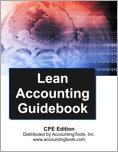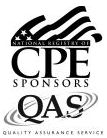Lean Accounting Guidebook (CPE Course)
CPE Credit: 14 hours
Course Type: Downloaded PDF materials with online test
Price (with PDF Textbook): $100
Course Description
The Lean Accounting Guidebook shows the accountant how to save money and minimize errors by streamlining the accounting department. It does so by describing more than 150 improvement tips for billing, collections, cost accounting, fixed assets, payables, payroll, and more. The accountant can use such tools as value stream mapping, flowcharting, traffic analysis, and measurement systems to decide which improvements would be the most useful to install. In short, this course provides the accountant with a complete toolkit of solutions for improving the accounting department.
Author: Steven Bragg
Course Number: AC1069
Table of Contents
Chapter 1. Overview of Lean Accounting
Chapter 2. Lean Customer Billing
Chapter 3. Lean Cash Receipts
Chapter 4. Lean Accounts Payable
Chapter 5. Lean Payroll
Chapter 6. Lean Financial Statements
Chapter 7. Lean Credit Management
Chapter 8. Lean Collections
Chapter 9. Lean Inventory Accounting
Chapter 10. Lean Cost Accounting
Chapter 11. Lean Fixed Asset Accounting
Chapter 12. The Lean General Ledger Environment
Chapter 13. The Lean Approach to Budgeting
Chapter 14. Lean Filing
Chapter 15. Lean Controls and Procedures
Learning Objectives
Cite the tools used to create a lean accounting system.
Identify the techniques used to reduce billing problems.
Specify the steps in the processing of cash receipts.
Cite the techniques used to streamline the processing of payables.
Specify the methods available for creating a leaner payroll process flow.
Recognize the revisions used to accelerate the closing process.
Cite the types of protections available for mitigating credit losses.
Recognize the tools used to manage the collections function.
Specify the methods used to increase inventory record accuracy.
State the types of traditional cost accounting reports, and the situations in which these reports can be used or avoided.
Recognize the characteristics of lean production environments, pull systems, and bottleneck-focused systems.
Specify the situations in which work-in-process tracking is not required.
Cite the effects of interest capitalization and the capitalization limit on fixed asset recordation.
State the effects of an acquisition on the general ledger.
Recognize the arguments favoring a reduction in the number of general ledger accounts.
Recognize the methods used to streamline and verify the budget model.
Cite the situations in which separation of duties is needed.
Describe how the outlier analysis concept can be used.
Recognize how controls can fail in special situations, such as during acquisitions, employee turnover, and rapid growth.
Specify the techniques available for minimizing employee movement within the accounting department.
Recognize the available solutions for minimizing record mis-filings and locating missing records.
Cite the situations in which separation of duties is needed.
Describe how the outlier analysis concept can be used.
Recognize how controls can fail in special situations, such as during acquisitions and employee turnover.
Specify how controls can remain robust during a period of rapid growth.
Identify the situations in which weak controls are acceptable.
Level: Overview
Instructional Method: QAS Self-Study
NASBA Category: Accounting
Prerequisites: None
Advance Preparation: None
Latest Review Date: January 2023
Program Registration Requirements: Click on "Purchase Course" near the top of this page to pay for and access the course. You will then be able to download the course as a PDF file, then take an on-line examination, and then download a certificate of completion if you pass the examination.
Program Refund Policy: For more information regarding administrative policies concerning complaints, refunds, and other matters, see our policies page.
AccountingTools, Inc. is registered with the National Association of State Boards of Accountancy (NASBA) as a sponsor of continuing professional education on the National Registry of CPE Sponsors. State boards of accountancy have the final authority on the acceptance of individual courses for CPE credit. Complaints regarding registered sponsors may be submitted to the National Registry of CPE Sponsors through its website: www.nasbaregistry.org.
The NASBA sponsor identification number for Accountingtools, Inc. is 115881.
AccountingTools is an IRS Approved Continuing Education Provider. We are compliant with the requirements for continuing education providers (as described in sections 10.6 and 10.9 of the Department of Treasury’s Circular No. 230 and in other IRS guidance, forms, and instructions). Our IRS Approved Continuing Education Provider number is 72821.


